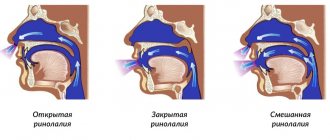Kinds
The classification of accelerated speech is based on pronunciation features and additional symptoms of the disease. There are 3 types of tachylalia:
- Pure form. Characterized by a fast pace of pronunciation. Phonemes and syntactic units do not change, there are no phonetic errors.
- Poltern. In the process of speaking, the child seems to “stumble,” making unjustified pauses and hesitations. Has difficulty finding words to express thoughts. Repeats already spoken syllables and words without reason. Poltern is easily confused with logoneurosis. It is worth paying attention to the fear of speech, the presence of convulsive movements at the time of articulation. When “stumbling” they are absent.
- Battarism. Speech breathing is impaired. The child chokes during articulation. Pronounces a phrase at an accelerated pace, but swallows syllables and words, and cannot organize a sentence into the correct lexical structure.
Preventive measures
It is important for parents of children to promote the correct formation of speech. Children imitate the speech of adults, so it is important to maintain a calm pace of conversation with them. It is important to monitor the correct pronunciation and speed of word reproduction.
Prevention for adults consists of timely and complete treatment of emerging pathologies. This applies to neurological diseases and neuroinfections. As for mental disorders, in such cases it is difficult to correct them. With timely consultation with a doctor, it is possible to reduce the severity of symptoms and the risk of complications.
Causes
According to statistical data from psychologists and neurologists, tachylalia is more often diagnosed in nervous, easily excited children suffering from hyperactivity.
The causes of violations include the following:
- Heredity
- Inner speech rate disorders
- Braking rate delay
- Copying the speech of others
- Incorrect education of a child’s speech in the family. The reluctance of adults to listen to the baby's long, slow tirade forces him to rush through articulation.
- Mental disorders.
Disorders associated with impaired speech rate
Associated symptoms depend on the underlying pathology that caused tachylalia. With mental disorders, patients are characterized by mood swings (from apathy to euphoria), delusional ideas, visual and auditory hallucinations. Such patients can cause harm to themselves.
The range of associated neurological disorders is wide. Patients may experience the following symptoms:
- paresis or paralysis of the limbs;
- increased muscle tone;
- the occurrence of violent (uncontrolled movements) - tremor, hyperkinesis;
- gait disturbances, the most common concern is unsteadiness when moving;
- decreased memory, attention, criticism;
- with tumors, patients may experience headaches, disturbances in vision, swallowing, and smell.
Epilepsy is always accompanied by convulsive seizures of varying frequency, while TBI is accompanied by any neurological symptoms (listed above). With congenital diseases, mental retardation of varying severity may be observed.
Symptoms
Tachylalia in children can be diagnosed based on speech and non-speech signs. The first include:
- expressiveness of speech;
- hesitation when speaking;
- speech breathing disorders;
- pronunciation of more than 20 sounds per second (the norm is no more than 12);
- repeated repetition of phonemes and words;
- omission of sounds, distortion of phonemes;
- violation of intonation;
- absence of logical pauses between words and phrases;
- articulatory motor skills;
- impairment of written speech;
- difficulties in learning to read;
- easier pronunciation of small sentences;
- impaired coordination of the speech apparatus;
- discrepancy between internal and external speech.
Non-speech symptoms include:
- motor restlessness;
- active gestures;
- sleep disorders;
- hyperactivity;
- disorientation;
- low level of concentration;
- violations of all types of memory;
- lack of consistency and logical thinking;
- autonomic disorders of various etiologies (sweating, excitability, increased heart rate).
Forecast
The prognosis depends on the underlying pathology. In neurological and mental diseases, the further fate is determined by the severity and location of the lesion. Adult patients often have moderate to severe disorders that are difficult to correct. The same applies to congenital pathologies.
The prognosis depends on the level of trust between the patient and the doctor and on how seriously the patient himself works on his recovery. Violations associated with defects in the upbringing of children and in the case of their imitation by adults respond well to correction.
Diagnostics
In order to recognize a speech pathology in a child, you must first contact not a speech therapist, but a neurologist or psychiatrist. Diagnosis of the disease occurs on the basis of analysis of external manifestations and laboratory research methods.
Most often, the doctor advises the preschooler to undergo the following procedures:
- EEG: to identify signs of epilepsy, disorders in the functioning of brain structures.
- Echogram (ultrasound): will determine the presence or absence of tumors and neoplasms.
- MRI: will reveal organic brain lesions.
A mandatory condition for diagnosing a speech disorder is an interview with a psychiatrist. The specialist determines the level of development of the preschooler, finds internal family and everyday reasons for the development of pathology. Excludes or confirms the presence of mental disorders.
A psychologist helps determine the level of motor, sensory, volitional, and cognitive development.
Speech function is examined by a speech therapist. The state of speech motor skills, the acoustic apparatus, the ability to place stress, pauses, and the pace of speech and writing are subjected to a thorough analysis.
A psychologist, psychiatrist, and speech therapist use diagnostic tests and specialized tasks when examining a child.
The diagnosis of tachylalia is made after a complete examination of the preschooler, collection of anamnesis and analysis of diagnostic results from all specialists.
Tips for teachers on working with children suffering from poultern and battarism
When planning classes with problem children, it is advisable to give preference to the following forms of work:
- Retelling a passage of text, reciting with and without gestures, telling a story, reading texts in roles, reading a phrase one word at a time, exercises for expressive speech, reading through a slot.
- Interactive games to develop logical thinking and come up with options for plot situations.
- Exercises to overcome inner speech defects, answers to questions, drawing up an answer plan, mathematical problems, tests.
- Development of auditory attention: memorization of heard proverbs, quatrains, and later - small passages in prose.
- Work on the tempo of speech: movements under the count, counting accompanied by movement; pronouncing syllables with tapping, reading with a metronome.
Of course, working with a speech therapist will bring results much faster. However, parents do not always have the opportunity to find a specialist. Don't despair. If the child does not have serious health problems, then parents can try to correct the speech rate themselves. We strongly recommend contacting specialists .
Correction
Work to overcome such disorders in preschoolers consists of several parts:
- Drug treatment. Prescribed by a neurologist, psychiatrist. These are sedatives that normalize the processes of the central nervous system.
- General strengthening procedures. Hardening, physiotherapy, normalization of general movements. These are exercises to slow down the pace, train coordination, develop skills of smoothness and rhythm.
- Speech therapy work. Aimed at developing correct voice control, rhythmic reading, smooth breathing, clear, calm speech, general behavior in a team, and expanding vocabulary.
Let's talk in more detail about the correctional work of a speech therapist with a preschooler. We recommend using the following set of exercises and tasks to eliminate tachylalia in childhood.
Breathing exercises
- Exercise 1
The child must breathe rhythmically, controlling the processes of inhalation and exhalation. The duration of inhalation is 3 seconds, exhalation is also 3, with a short pause between them = 1 second. Inhale, count 1-2-3, pause - 1, exhale -1-2-3. First the teacher counts, then the child counts to himself. Inhale through the nose, exhale through the mouth. Repeat the exercise 4 times several times a day.
- Exercise 2
We breathe while walking. Step - inhale, 2 steps - exhale, step - pause. Repeat 3-4 times several times a day.
- Exercise 3
Pronouncing sounds while exhaling. We stand up straight, take a normal breath, and exhale pronounce the sound Ш, Ф, Х. Make sure your cheeks are calm, they should not puff up. The inhalation lasts at least 5 seconds. Repeat the exercise with one letter 4 times. After a few days the sound can be changed.
- Exercise 4
We pronounce the syllables. The child breathes calmly and stands up straight. Simulates chewing movements, while exhaling slowly pronounces the syllables: HMMA - HMMO, HMMU-HMMY, HNNNI-HMMI, etc.
- Exercise 5
We say the words while exhaling. The preschooler takes a slow, deep breath and, as he exhales, slowly counts to 5 out loud. If he has enough air to pronounce all the numbers, increase their number so that there is a need for additional oxygen. Repeat the exercise 4 times.
Logorhythmics
Exercises are necessary to establish the correct rhythm of movements and articulations. The child learns to control the pace of speech.
- Speech warm-up. A preschooler should not focus on speech material. Choose any semantic group of words. While counting slowly, he walks and pronounces the months, the names of the days of the week, and counts.
- We walk slowly in a circle, clapping our hands at the pace of speech. We pronounce women's names, parts of the human body. Watch the rhythm of your speech.
- We collect mushrooms and harvest in the garden. The child walks around the hall, picking up toy fruits, vegetables, and mushrooms from the floor. Calls them. Movements and articulation occur at a slow pace.
Mastering a slow speech rate
- Listening to a recording with text. The announcer reads very slowly. The material should not be large or complex. The child needs to remember the text and repeat it just as slowly.
- Listening to an accelerated recording of the speaker's monologue. Repeat at a slow pace.
- Singing in a given rhythm. Use a tape recording. The child must sing in sync with the recording. Stop him if he runs forward.
- Joint pronunciation of texts and phrases. The speech therapist says a sentence, then repeats it at the same time as the student. Achieve synchronicity, a slow pace. Repeat the phrase several times until you get a positive result.
Work with text
Suitable for reading children. Use rhythmic texts, proverbs, sayings. The child must read them syllable by syllable, out loud.
The teacher can clap the rhythm of reading so that the child does not get confused and does not rush.
- Tasks to shorten or lengthen text.
The preschooler is offered a short story. You need to read it out loud and understand the meaning. Retell, shortening or adding your own feelings from what you read.
- Making sentences with suggested words
The teacher offers a synonymous series. For example, winter - cold season - cold, etc. The preschooler must make sentences with them and pronounce them clearly in a slow rhythm.
- Retelling of a famous text
A preschool student retells a story or fairy tale he knows. Watch for pauses, vocabulary, formulation of thoughts, and sequence of presentation.
Corrective work with children suffering from tachylalia takes at least 6 months, with polternism and battarism at least a year.
Etiology of dysfunction
Human speech develops in accordance with conditioned reflexes. Its indicators are determined by the state of the brain, which provides connections with the articulatory apparatus. Nerve impulses transmit a signal about the need to move the speech organs. Thus, in order for its characteristics to coincide with the norm, the child must have normal functions of the central nervous system, organs of the speech apparatus and the absence of hearing pathologies. The task of speech therapy and psychology is to assess speech indicators and work on its deviations.
One of the conditions for its development is the child’s communication with adults and peers. According to etiology, speech disorders are divided into functional (neurogenic logoneuroses and social type), organic (in the presence of somatic pathologies). Dysfunctions can be a consequence of trauma during childbirth, long-term infectious diseases suffered at an early age. External factors include an unfavorable family environment associated with a lack or excess of parental attention.
According to one version, tachylalia manifests itself in children whose parents speak quickly, that is, the role of a genetic factor is noted. According to V. A. Kurshev, fast speech speed is associated with the pace of thinking, and the violation refers to mental and speech deviations. D. Weiss (1950) spoke about the connection between pathology and stuttering. M.E. Khvattsev (1959) believed that the reason for the congenital speech motor insufficiency of the apparatus lies in the lack of an example on the part of adults. V. M. Bekhterev (1926) argued that its cause lies in the predominance of excitation processes. M. Nadolechny characterized persons with battarism as hasty and restless people with weak memory and attention disorders.
To correct speech underdevelopment, methods of psychological stimulation, vasoactive therapy, and speech therapy are used. Tachylalia can be pure and functional, accompanied by stuttering. Its clinical picture is often accompanied by violations of vocabulary, grammar, and phonetics. Its separate subspecies are battarism and paraphrase.
Etiological factors include somatic diseases, psychogenic environment and habit. According to the results of neurological studies, even in the prenatal period, the fetus undergoes corresponding physiological and anatomical changes in the brain.
Poltern is in speech therapy
Yu. A. Florenskaya believed that the mechanisms of paraphrasia and aphasia are the same. The main disorder in aphasia and paraphasia is associated with difficulty in voluntarily finding words and is expressed as: violation of the correct flow of syntactic sequences of speech, looseness of sentences, involuntary insertion of additional elements into speech, violation of the letter composition of a word, the presence of literal paraphrases.
Poltern (stumbling)
- pathologically accelerated speech with the presence of intermittent speech tempo of a non-convulsive nature (stammering, stumbling, unreasonable pauses). Characterized by a violation of general and speech motor skills. Often combined with other speech disorders.
Starting from the works of Aristotle, it is considered in a group of various disorders of organic and functional origin. Since the end of the 19th century. it is identified as an independent speech disorder. Experimental studies are aimed at distinguishing stumbling primarily from stuttering. A. Kussmaul (1879) identified dyslogical speech disorders, or dysphrasia, caused by a violation of the content side of speech, and spasmodic laloneuroses, to which he classified stuttering as a purely articulatory speech disorder. He was the first to point out the possibility of confusing stumbling with stuttering and proposed a way to distinguish between these disorders: attracting attention to speech in stutterers increases convulsiveness, in people with stumbling it improves speech; People who stutter at home speak better, and people who stumble speak worse.
An analysis of the signs of half-turn and stuttering shows that in the first case, people usually do not realize their shortcoming, while people who stutter suffer from it. With concentrated attention, speech with half turns and paraphrases improves, and with stuttering, it worsens. In the presence of certain people or in a responsible environment, children with paraphrase and polternes speak better, while those who stutter speak worse. During casual conversation, the symptoms of polternes and paraphrasia intensify, while the symptoms of stuttering decrease.
In the 30-50s of this century, electroencephalographic studies were conducted confirming the differences between stuttering and stumbling.








